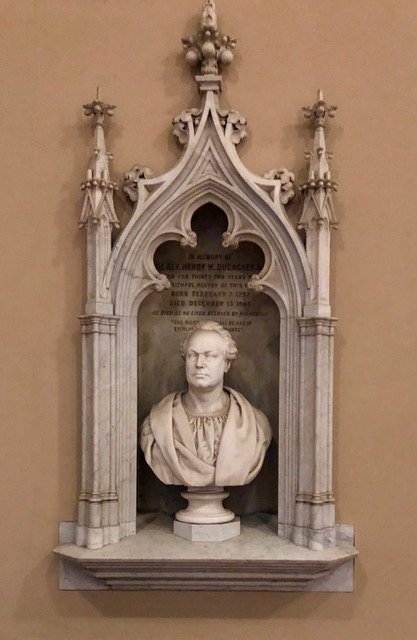Friday Feature: A newly identified Furness design at St. Stephen’s!
Memorial for Rev. Dr. William Rudder, 1880
On New Year’s Eve, a friend, architectural historian Michael J. Lewis, sent me an email that made my eyes pop: It included an 1880 article about a memorial plaque at St. Stephen’s that’s long intrigued me but that I could find little about in our archives.
The plaque, I knew, honors the rector involved in architect Frank Furness’ 1878 additions to, and redecoration of, the church, The Rev. Dr. William Rudder, who died soon after. The article sent by Mike, an authority on Furness, identified our memorial as also designed by Furness (The Churchman, Sept. 25, 1880, 345). The article also extolled this memorial as “probably unique” in the United States and of a “rare beauty” that equaled that of the church’s existing art. Wow. Thanks, Mike.
The timing of Mike’s gift was also uncanny. I’d closed St. Stephen’s anniversary year, 2023, with an imaginary tour of Furness’ redecorated sanctuary, based on an 1878 article also in The Churchman provided by another Mike, Mike Krasulski of Philadelphia. See the post here.
So I open 2024 with my first thoughts using “new eyes,” thanks to this New Year’s gift. I hope to revisit Furness’ St. Stephen’s project with insights from Mike Lewis’ ongoing work. We’ll give him all we can in the process.
The plaque, described by The Churchman as funded by the parish ladies and confirmed in the Vestry Minutes as a parish subscription, remains in its original site on the south wall under the gallery.
Strickland and Struthers, Montgomery Memorial, c. 1834
As The Churchman notes, the memorial joins those on the south wall for Dr. Rudder’s predecessors as rector, Rev. James Montgomery and Dr. Henry Ducachet. They’re all different; the most radically so, however, is Dr. Rudder’s even to its size (about 4x6 feet).
Unknown, Ducachet Memorial, c. 1865
Luckily for us, The Churchman offers details on the memorial’s materials, makers, and content. The incised Pennsylvania black-marble frame, with a grayish-white inlaid vine motif, it reports, was produced by St. Stephen’s stoneworkers Struthers & Sons since the church was built (1822-3). The marble surrounds an engraved brass plaque attributed to a New York stained-glass studio, J & R Lamb, a resource I’ve not otherwise found at St. Stephen’s.
Using The Churchman article as a guide (which differs in some details), I began to study the work itself, now apparently darkened and mottled with exposure; I lightened the photograph for clarity. I saw the memorial communicates in various ways, some especially subtly. The brass plaque offers a brief inscription highlighting Dr. Rudder’s degree in divinity, tenure at St. Stephen’s and death date, accompanied by symbols of Christ and the Church: The text appears within a vesica piscis (a fish bladder or almond-shaped symbol of life or Christ) surmounted by Christ’s monogram. The vesica is framed by symbols of the four Evangelists (the lion [St. Mark], ox [St. Luke], eagle [St. John], and angel [St. Matthew], all winged). The vine climbing on three sides of the marble frame, symbol of immortality, reiterates the text at the bottom, a partial quote from Scripture promising immortality: “.... And I will give thee a crown of life” which is preceded by “be thou faithful unto death…. (Rev. 2:10, KJV)."
The plaque’s symbols and text, however, imply that Dr. Rudder amply met that Scriptural condition. They portray him as a man of deep faith, an eminent servant of Christ and the Church, and formidable intellectual. The intersecting bands that anchor the vesica containing Dr. Rudder’s biography suggest a cross, further securing Dr. Rudder in Christ’s embrace.
Then there’s the surface play—and color. The sheen of the incised black marble, matte black patina on brass, and maroon around the Evangelists’ symbols and of Rudder’s name play against accents of polished yellow-gold metal. Red, the color of Jesus’ self-sacrifice, links Rudder yet again with the God-man and the Church. The wealth of information is conveyed with tact and quiet power.
Aesthetically, I support the idea that Furness designed this plaque memorial though it’s far outside our received vision of his “architectural” work. Its combination of delicacy and boldness, space and compressed, compartmentalized forms (the Evangelists’ symbols), and geometric patterns seems akin to those on surfaces of his designs for interiors and furniture.
The more I looked and thought, the more I felt this 1880 memorial fit perfectly within Furness’ lost stencil scheme at St. Stephen’s. The plaque’s colors relate especially to the lower walls described in the 1878 article I explored in December: Furness’ stenciled bands there were maroon and gold...... Floating just above those walls, this monumental plaque echoes that palette and patterning. See if this detail of the opposite (north) wall in the sepia photo helps to imagine this elegant memorial in its original setting.
Come see it to imagine it then as well as to explore it now. We are, I hope, on the brink of new thinking about Furness’ surfaces and colors.
— Suzanne Glover Lindsay, St. Stephen’s historian and curator



